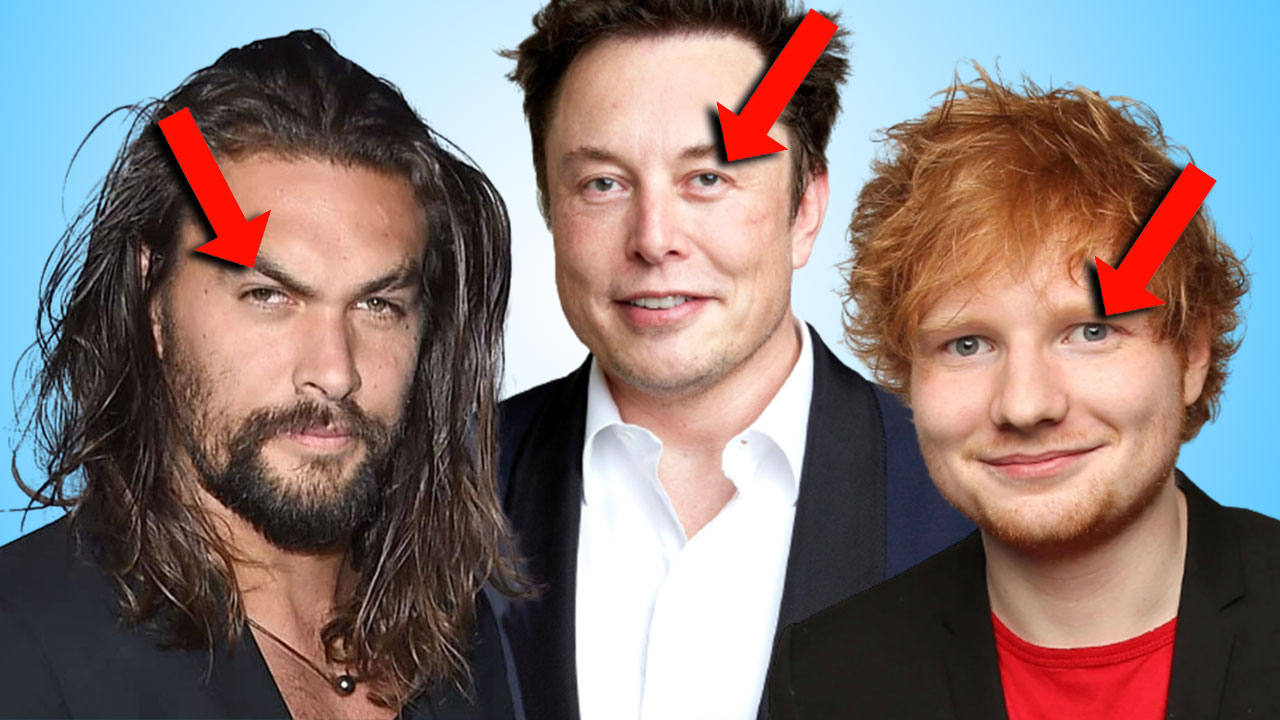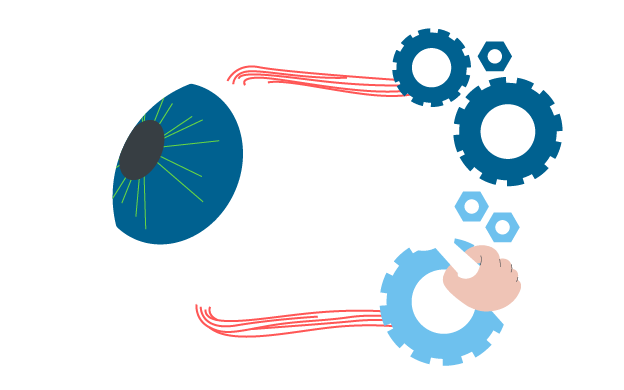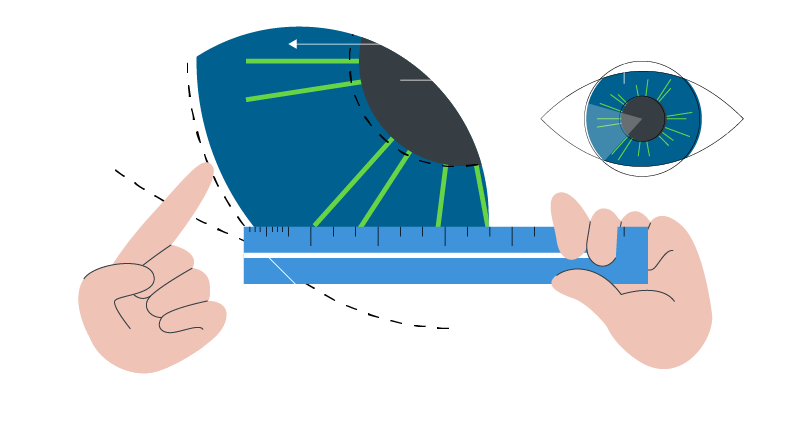A lazy eye (strabismus) can be large - or small angled.[1]
A slight lazy eye is of the small angle sort.
I was born with a squint. And like so many other people with squint (or more commonly known as strabismus) - I tried everything to fix it.
A slight lazy eye is very common. Jason Momoa has it, Ed Sheeran has it - and so does Elon Musk:

In fact, up to 4% of US citizens suffer from a lazy eye. Some of them have developed the condition over their lifetime. Other people are born pre-maturely – and got it at birth. [2]
So did I.

I got a big lazy eye at birth. And like so many other people either born with strabismus - I tried everything to fix it. Surgery, eye drops, vision therapy, exercises - you name it. The full nine yards.
Ultimately, my big lazy eye, turned into a slight - barely noticeable lazy eye.
In this article you'll learn everything you need to know about a slight lazy eye: What it is - what caused it - and how to treat it.
Let's dive right in
1.Slight Lazy Eye: What Is It? And What Caused It?

Albert Einstein most famously said: “If you can't explain it to a six-year-old, you don't understand it yourself."
Every problem can be solved only if it's properly understood. So in this chapter, we'll clear some basics about strabismus/ crossed eyes:
1.1 What Does It Mean When Someone has A Lazy Eye?
Strabismus, often called lazy eye, means that a person has misaligned eyes.
Meaning: Both eyes are not pointing in the same direction (either due to muscular issues, or brain issues - or both in summation). [3]
While 'lazy eye' and 'strabismus' is technically not the same thing - 'lazy eye' is amblyopia [4], and strabimus is 'eye misalignment' - it's often used interchangeably. So, in this article, I'll be using both terms interchangeably as well.
1.2 What Causes A Slight Lazy Eye In Children?
A common cause of a lazy eye is the child being born too early [5], or a family history of eye disorders.
The odds of inheriting a strabismus doubles if your parents are suffering from a lazy eye [6] - but given that the net chances of strabismus are low, the actual risk of developing strabismus only due to family history is low.
Why? Because if you double a very low risk, it is still - well - very low.
1.3 What Causes A Slight Lazy Eye In Adults?
The same mechanism is likely to be at work as an adult. The brain favors one eye (the stronger eye), which results in a slight eye deviation of the weaker eye. Which makes the central nervous system unable to process the two images of both eyes... [7]
.. leading to a negative spiral until ultimately, one eye is completely dominant. [8]
1.4 Is It Normal To Have A Slight Lazy Eye?
No, it is not.
While it is not uncommon for some individuals to have a slight lazy eye, it is important to sign up for regular eye examination to monitor for any changes, and potentially to determine the best course of treatment.
I want to stress this again: A slight lazy eye is not normal, and should be diagnosed and corrected early.
Otherwise, it could lead to amblyopia (blur vision in one eye).
1.5 What Are The Most Common Lazy Eye Symptoms?
There are many symptoms to having a lazy eye:
- Misaligned eyes: In other words, the eye movement is abnormal in relation to normal vision. So, one eye looks in one direction - the one eye looks in another.
To people with strabismus, this is socially unpleasant, and makes normal things such a finding a partner more difficult for the patient. As humans have evolved to favor symmetry in their significant others. [9]
This is why the number one reason for surgery in adult strabismus is psychosocial (in plain English, this means for social reasons/ interacting with others). [10]
- Poor depth perception: Which makes it impossible to watch 3d movies. Or makes every day tasks that depend on depth perception, such as parking, more difficult.
- Double vision (diplopia): This is a common symptom of strabismus, which is a condition characterized by crossed eyes or misaligned eyes.
1.6 Eye Misalignment Can Lead To Amblyopia (Weaker Eye)
Strabismus can lead to amblyopia - which means that crossed eyes can lead to permanent blurry vision in the weaker eye. Amblyopia (permanent vision loss) is the worst thing that can happen when you have strabismus. [11]
I personally suffer from impaired vision in my left eye since my teenage years. Overnight, I've lost 80% of my visual acuity.
Luckily, my poor vision in my left eye is not influencing my life quality that much (yep, no lifelong vision problems) - as the refractive error can be completely treated with contact lenses.
1.7 Do lazy eyes get worse?
If not treated, generally yes. [12]
It's hard and close to impossible to treat amblyopia. The magic here lies in prevention.
If I could urge my younger self to go to an eye doctor more often and check for amblyopia symptoms (vision check) - I'd do it.
Amblyopia (lazy eye) is serious and if you suffer from eye misalignment - you should check with your doctor often. If you get an early diagnosis, you can use preventative treatment options to strengthen your weaker eye.
2. Slight Lazy Eye Treatment: How To Cure It - Quickly?

Fortunately, there are several ways to treat a slight lazy eye, including corrective glasses or contact lenses, eye muscle exercises, and surgery.
The most appropriate treatment will depend on the specific cause and severity of the condition, as well as the age of the patient.
In this section, we will explore the different options for treating crossed eyes and the potential benefits and risks associated with each method. So if you are to seek treatment, you can make an educated decision going forward:
2.1 Can You Fix A Lazy Eye?
In short: Yes. Strabismus is a completely treatable condition. [13]
The earlier it gets diagnosed and treated, the better. Yet even adult strabismus, with the right surgeon, have reported wonderful success rates. [14]
2.2 What Are The Best Ways To Permantly Fix A Lazy Eye?
The only way to fix eye misalignment - is where it originated. We have to train – or force via operative means - both our eyes in the same direction.
- Eye muscle surgery works that way: The surgeon forces your eye muscles to pull in the same direction via a surgical treatment. This tends to be the most common way to fix crossed eyes - with over 1,2 million strabismus surgeries done per year in the United States. [15]
- And so do all vision therapy methods: The Brock String, VR Training, various Amblyopia Games – they train your eye muscles to look in the same direction.
- Prism glasses (almost) do work that way: The glasses change the light rays direction, making sure the light rays hit the right part of the retina. [16]
Squint (strabismus) can be treated or strongly improved without a surgical procedure. Yet surgery is the most common procedure recommended for strabismus.
However even though it's high recommended by doctors, only 1 out of 20 people that suffer from strabismus opt for surgery. But why? [17]
2.3 Are There Alternative Treatment Options To A Slight Lazy Eye?
While eye surgery is a standard, and very effective way to treat strabismus - most patients (including me) were interested in alternatives. Especially when the angle is not as big, and the condition is intermittent.
Because surgery is perceived to be risky, costly and quite painful - most people are looking for an easier treatment to start...
This is where our Lazyeyefix Ai software could come in handy. It's designed to help the 19 out of 20 people with strabismus that are not yet ready for surgery [18], yet still want to improve their condition.
2.4 What Is Lazyeyefix Ai?
It's more fun than eye exercises at home, more quantifiable than the Brock String, and less risky, costly and painful than strabismus surgery. In short:
- It helps control eye movement - to prevent eye turns - and help the eyes point in the same direction.
- It's as effortless as possible . no actual training time, so say bye-bye to daily 20min+ eye exercises.
- It's easy-to-use with no doctor supervision - no weird consultations.
- And you can pretty much start immediately and well, improve your crossed eye condition immediately.
And yeah, we have a free trial where you can basically try it with no risk.
Feel free to click the link here to download your free trial for Windows.
Or click here to download your free trial for Mac.
References:
[1] Large-angle strabismus: can a single surgical procedure achieve a successful outcome? https://pubmed.ncbi.nlm.nih.gov/21091333/
[2] Born Too Soon - By WHO:
http://apps.who.int/iris/bitstream/handle/10665/44864/9789241503433_eng.pdf?sequence=1
[3] Strabismus by Cleveland Clinic:
https://my.clevelandclinic.org/health/diseases/15065-strabismus-crossed-eyes
[4] The Amblyopia Treatment Studies: Implications for Clinical Practice: https://www.ncbi.nlm.nih.gov/pmc/articles/PMC5396957/
[5] Born Too Soon - By WHO:
http://apps.who.int/iris/bitstream/handle/10665/44864/9789241503433_eng.pdf?sequence=1
[6] Genetic Basis of Congenital Strabismus:
https://jamanetwork.com/journals/jamaophthalmology/fullarticle/817192
[7] Fovea is 1% of the eye yet makes up 50% of the visual system: https://psych.hanover.edu/classes/sensation/chapters/Chapter%203.pdf
[8] Frederick Brock on Strabismus:
https://stereosue.com/wp-content/uploads/2020/05/The-Work-and-Wisdom-of-Dr.-Frederick-W.-Brock.pdf
[9] Facial attractiveness: evolutionary based research:
https://www.ncbi.nlm.nih.gov/pmc/articles/PMC3130383/
[10] Adults with strabismus seek surgery for pyschosocial benefits: https://www.sciencedirect.com/science/article/pii/S2211505613000793
[11] The Amblyopia Treatment Studies: Implications for Clinical Practice: https://www.ncbi.nlm.nih.gov/pmc/articles/PMC5396957/
[12] Variability of control in intermittent exotropia:
https://pubmed.ncbi.nlm.nih.gov/17629562/
[13] American Optometric Association:
https://www.aoa.org/healthy-eyes/eye-and-vision-conditions/strabismus
[14] Adults with strabismus seek surgery for pyschosocial benefits: https://www.sciencedirect.com/science/article/pii/S2211505613000793
[15] Surgery is a routine procedure:
https://www.aao.org/eye-health/tips-prevention/lazy-eye-surgery-facts
[16] What Is Prism Correction In Eye Glasses?
https://www.aao.org/eye-health/glasses-contacts/what-is-prism-correction-in-eyeglasses
[17] Strabismus, Strabismus Surgery, and Reoperation Rate in the United States: Analysis from the IRIS Registry: https://pubmed.ncbi.nlm.nih.gov/29779683/
[18] Strabismus, Strabismus Surgery, and Reoperation Rate in the United States: Analysis from the IRIS Registry: https://pubmed.ncbi.nlm.nih.gov/29779683/






